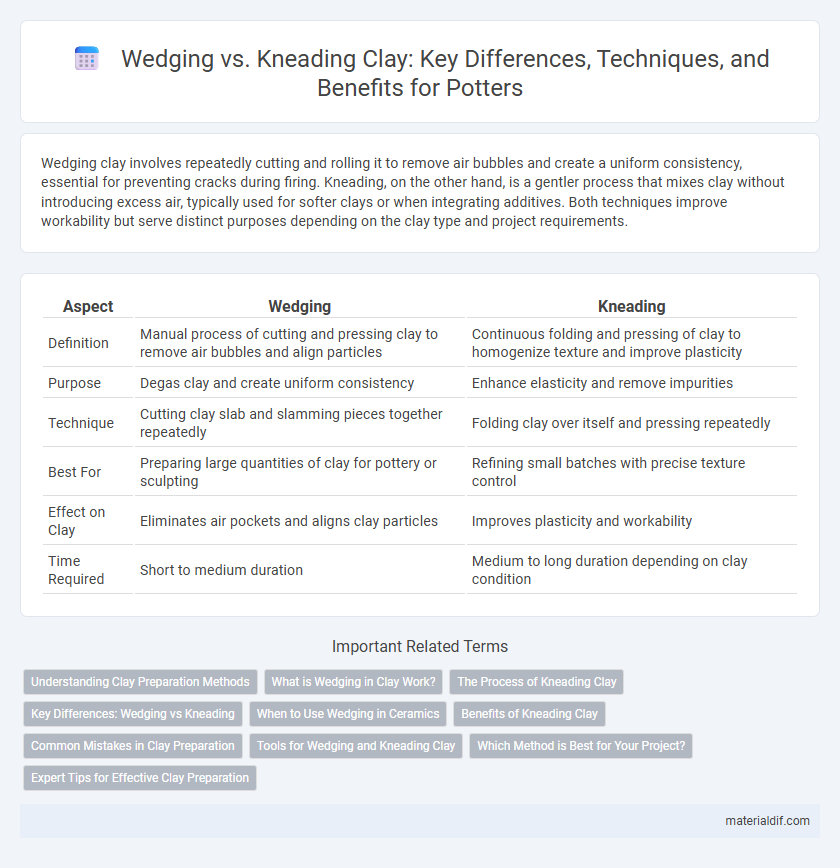Wedging clay involves repeatedly cutting and rolling it to remove air bubbles and create a uniform consistency, essential for preventing cracks during firing. Kneading, on the other hand, is a gentler process that mixes clay without introducing excess air, typically used for softer clays or when integrating additives. Both techniques improve workability but serve distinct purposes depending on the clay type and project requirements.
Table of Comparison
| Aspect | Wedging | Kneading |
|---|---|---|
| Definition | Manual process of cutting and pressing clay to remove air bubbles and align particles | Continuous folding and pressing of clay to homogenize texture and improve plasticity |
| Purpose | Degas clay and create uniform consistency | Enhance elasticity and remove impurities |
| Technique | Cutting clay slab and slamming pieces together repeatedly | Folding clay over itself and pressing repeatedly |
| Best For | Preparing large quantities of clay for pottery or sculpting | Refining small batches with precise texture control |
| Effect on Clay | Eliminates air pockets and aligns clay particles | Improves plasticity and workability |
| Time Required | Short to medium duration | Medium to long duration depending on clay condition |
Understanding Clay Preparation Methods
Wedging and kneading are essential clay preparation methods that improve plasticity and remove air bubbles, ensuring uniform texture for pottery. Wedging involves pushing and rolling the clay in a rhythmic motion, aligning clay particles to create a consistent structure ideal for hand-building techniques. Kneading, often more vigorous, incorporates additives like water or grog while thoroughly mixing the clay, enhancing workability for wheel throwing and preventing cracking during firing.
What is Wedging in Clay Work?
Wedging in clay work is a critical preparation technique used to remove air bubbles and achieve uniform consistency by repeatedly pressing and folding the clay. This process aligns the clay particles, improving plasticity and workability before shaping or molding. Proper wedging prevents cracks and weak spots during firing, ensuring a stronger final ceramic piece.
The Process of Kneading Clay
Kneading clay involves consistently pressing, folding, and rolling the material to remove air bubbles and ensure uniform moisture distribution. This process enhances the clay's plasticity, making it more workable and less prone to cracking during shaping or firing. Proper kneading improves the overall strength and durability of the finished ceramic piece.
Key Differences: Wedging vs Kneading
Wedging involves repeatedly slamming and rotating clay on a surface to remove air bubbles and create a uniform texture, essential for pottery and wheel throwing. Kneading is a gentler process where clay is pressed and folded to improve consistency and workability, often used in smaller quantities or softer clays. The key difference lies in wedging's aggressive technique for thorough air removal versus kneading's softer approach aimed at preparing clay for shaping without extensive structural alteration.
When to Use Wedging in Ceramics
Wedging in ceramics is essential when preparing clay for consistent texture and removing air bubbles before shaping. Use wedging primarily with softer clay bodies or fresh clay to ensure plasticity and even moisture distribution. This technique enhances workability and prevents cracks during firing by homogenizing the clay structure.
Benefits of Kneading Clay
Kneading clay improves the material's elasticity and uniformity, making it easier to shape and less prone to cracking during drying and firing. This process removes air bubbles and ensures a consistent moisture distribution, which enhances the durability of the final ceramic product. By strengthening the clay's structure, kneading optimizes workability and contributes to higher-quality craftsmanship.
Common Mistakes in Clay Preparation
Common mistakes in clay preparation include insufficient wedging, which leads to air bubbles causing cracks during firing, and over-kneading that can make clay overly dense and less plastic. Beginners often confuse wedging and kneading, neglecting the crucial step of aligning clay particles through proper wedging to ensure consistent texture. Failure to remove impurities and maintain even moisture content during clay preparation frequently results in structural weaknesses and uneven drying.
Tools for Wedging and Kneading Clay
Wedging clay requires tools like a wedging table, wire cutter, and wedging board to ensure even moisture distribution and remove air bubbles. Kneading clay involves manual pressure and often uses a rib or paddle to help compress and homogenize the clay body. Proper tools for wedging and kneading enhance the clay's plasticity and workability, crucial for successful pottery creation.
Which Method is Best for Your Project?
Wedging clay involves repeatedly rolling and pressing to remove air bubbles and create uniform texture, ideal for smaller projects requiring precision and fine control. Kneading incorporates folding and compressing larger clay masses to improve consistency and remove impurities, which is better suited for bulk preparation and large-scale sculpting. Choosing the best method depends on project scale, desired clay pliability, and the need for air bubble elimination to prevent cracks during firing.
Expert Tips for Effective Clay Preparation
Wedging aligns clay particles by removing air bubbles, enhancing plasticity and workability, while kneading blends different clay bodies for consistent texture and moisture content. Experts recommend a controlled wedging rhythm to avoid overworking, preserving clay's natural structure, and thorough kneading when combining clay types to achieve uniform consistency. Proper clay preparation reduces defects like cracking and ensures optimal performance during shaping and firing.
Wedging vs Kneading Infographic

 materialdif.com
materialdif.com